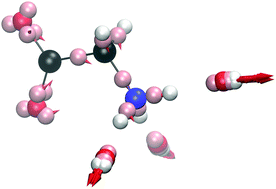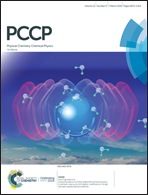Toward theoretical terahertz spectroscopy of glassy aqueous solutions: partially frozen solute–solvent couplings of glycine in water†
Abstract
The molecular-level understanding of THz spectra of aqueous solutions under ambient conditions has been greatly advanced in recent years. Here, we go beyond previous analyses by performing ab initio molecular dynamics simulations of glycine in water with artificially frozen solute or solvent molecules, respectively, while computing the total THz response as well as its decomposition into mode-specific resonances based on the “supermolecular solvation complex” technique. Clamping the water molecules and keeping glycine moving breaks the coupling of glycine to the structural dynamics of the solvent, however, the polarization and dielectric solvation effects in the static solvation cage are still at work since the full electronic structure of the quenched solvent is taken into account. The complementary approach of fixing glycine reveals both the dynamical and electronic response of the solvation cage at the level of its THz response. Moreover, to quantitatively account for the electronic contribution solely due to solvent embedding, the solute species is “vertically desolvated”, thus preserving the fully coupled solute–solvent motion in terms of the solute's structural dynamics in solution, while its electronic structure is no longer subject to solute–solvent polarization and charge transfer effects. When referenced to the free simulation of Gly(aq), this three-fold approach allows us to decompose the THz spectral contributions due to the correlated solute–solvent dynamics into entirely structural and purely electronic effects. Beyond providing hitherto unknown insights, the observed systematic changes of THz spectra in terms of peak shifts and lineshape modulations due to conformational freezing and frozen solvation cages might be useful to investigate the solvation of molecules in highly viscous H-bonding solvents such as ionic liquids and even in cryogenic ices as relevant to polar stratospheric and dark interstellar clouds.



 Please wait while we load your content...
Please wait while we load your content...